Comparison of Volunteers’ Head Displacement with Computer Simulation—Crash Test with Low Speed of 20 km/h †
Abstract
1. Introduction
2. Research Methodology
- Experimental “crash-test” research conducted with the participation of volunteers;
- Simulation studies performed in the MSC ADAMS program.
3. The Course of Experimental Research
4. The Course of Simulation Tests
- system of rigid bodies;
- known dimensions, masses, and moments of inertia;
- a model in which the movement takes place on a three-dimensional plane;
- connection of solids by means of joints;
- the only input affecting the system is the initial speed vx (chair speed);
- belts and seats modeled on the basis of experimental research.

5. Initial Conditions of Computer Simulation
6. Results
7. Discussion
8. Conclusions
Author Contributions
Funding
Institutional Review Board Statement
Informed Consent Statement
Data Availability Statement
Conflicts of Interest
References
- Jaśkiewicz, M.; Jurecki, R.; Witaszek, K.; Więckowski, D. Overview and analysis of dummies used for crash tests. Zesz. Nauk./Akad. Morska Szczec. 2013, 35, 22–31. [Google Scholar]
- Nycz, D.B. Influence of impact angle and humidity on TB11 virtual crash tests for SP-05/2 road safety barrier. Arch. Motoryz. 2016, 73, 71–88. [Google Scholar]
- Sances, A.; Friedman, K.; Gaston, F.; Bish, J. Serious injury in rear vehicular impacts. In Proceedings of the First Joint BMES/EMBS Conference. 1999 IEEE Engineering in Medicine and Biology 21st Annual Conference and the 1999 Annual Fall Meeting of the Biomedical Engineering Society, Atlanta, GA, USA, 13–16 October 1999; p. 503. [Google Scholar] [CrossRef]
- Pike, J. A Biomechanical Face for the Hybrid III Dummy. In Head Injury Biomechanics: Volume 1 the Skull; SAE: Warrendale, PA, USA, 2011; pp. 91–103. [Google Scholar]
- Rouhana, S.W.; Kankanala, S.V.; Prasad, P.; Rupp, J.D.; Jeffreys, T.A.; Schneider, L.W. Biomechanics of 4-point seat belt systems in farside impacts. Stapp Car Crash J. 2006, 50, 267–298. [Google Scholar] [PubMed]
- Jaśkiewicz, M.; Frej, D.; Matej, J.; Chaba, R. Analysis of the Head of a Simulation Crash Test Dummy with Speed Motion. Energies 2021, 14, 1476. [Google Scholar] [CrossRef]
- Alvarez, V.S.; Halldin, P.; Kleiven, S. The Influence of Neck Muscle Tonus and Posture on Brain Tissue Strain in Pedestrian Head Impacts. Stapp Car Crash J. 2014, 58, 63–101. [Google Scholar] [PubMed]
- Amiri, S.; Naserkhaki, S.; Parnianpour, M. Modeling and validation of a detailed FE viscoelastic lumbar spine model for vehicle occupant dummies. Comput. Biol. Med. 2018, 99, 191–200. [Google Scholar] [CrossRef] [PubMed]
- Nordhoff, L.; Freeman, M.; Siegmund, G. Biodynamics of the Living Human Spine During—Gx Impact Acceleration, SAE Paper No. 791027, Society of Automotive Engineers, Warrendale, PA, 1979. In Human Subject Crash Testing: Innovations and Advances; SAE: Warrendale, PA, USA, 2007; pp. 57–97. [Google Scholar]
- Sherwood, C.P.; Mueller, B.C.; Nolan, J.M.; Zuby, D.S.; Lund, A.K. Development of a frontal small overlap crashworthiness evaluation test. Traffic Inj. Prev. 2013, 14, 128–135. [Google Scholar] [CrossRef]
- Cormier, J.; Gwin, L.; Reinhart, L.; Wood, R.; Bain, C. A Comprehensive Review of Low-Speed Rear Impact Volunteer Studies and a Comparison to Real-World Outcomes. Spine 2018, 43, 1250–1258. [Google Scholar] [CrossRef]
- Moon, J.; Bae, I.; Kim, S. A pre-crash safety system for an occupant sitting on a backward facing seat for fully automated vehicles in frontal crashes. In Proceedings of the 2017 IEEE International Conference on Vehicular Electronics and Safety (ICVES), Vienna, Austria, 27–28 June 2017; pp. 168–171. [Google Scholar] [CrossRef]
- Stańczyk, T.L.; Zuska, A. Review of anthropodynamic dummies used to evaluate the effect of vibrations on sitting human (vehicle driver). Arch. Automot. Eng. Arch. Motoryz. 2014, 65, 65–74. [Google Scholar]
- Goo, A.; Laubscher, C.A.; Farris, R.J.; Sawicki, J.T. Design and Evaluation of a Pediatric Lower-Limb Exoskeleton Joint Actuator. Actuators 2020, 9, 138. [Google Scholar] [CrossRef]
- Nordhoff, L.; Freeman, M.; Siegmund, G. Strength and Response of the Human Neck, SAE Paper No. 710855, Society of Automotive Engineers, Warrendale, PA., 1971. In Human Subject Crash Testing: Innovations and Advances; SAE: Warrendale, PA, USA, 2007; pp. 225–250. [Google Scholar]
- Shadrin, S.S.; Ivanov, A.M. Testing Procedures and Certification of Highly Automated and Autonomous Road Vehicles. In Proceedings of the 2021 Systems of Signals Generating and Processing in the Field of on Board Communications, Moscow, Russia, 16–18 March 2021; pp. 1–5. [Google Scholar] [CrossRef]
- Frej, D.; Podosek, K.; Kelvin, T. Overview of design solutions for child seats. Arch. Automot. Eng. Arch. Motoryz. 2021, 92, 33–47. [Google Scholar] [CrossRef]
- Hu, J.; Klinich, K.D.; Manary, M.A.; Flannagan, C.A.C.; Narayanaswamy, P.; Reed, M.P.; Andreen, M.; Neal, M.; Lin, C.H. Does unbelted safety requirement affect protection for belted occupants? Traffic Inj. Prev. 2017, 18, 85–95. [Google Scholar] [CrossRef] [PubMed]
- Anthropomorphic Dummy Head for Use in Vehicle Crash Test. Available online: https://patents.google.com/patent/US20020083783A1/en?oq=US2002083783+(A1) (accessed on 17 October 2002).
- Jaśkiewicz, M.; Więckowski, D.; Witaszek, K. Przegląd i analiza manekinów stosowanych do testów zderzeniowych (Review and analysis of crash test dummies), Zeszyty Naukowe. Mech. Politech. Opol. 2013, 101, 47–48. [Google Scholar]
- Jaśkiewicz, M.; Więckowski, D.; Poliak, M.; Frej, D. Shoulder joint design of the anthropometric dummy used for crash tests. In Proceedings of the 2020 XII International Science-Technical Conference AUTOMOTIVE SAFETY, Kielce, Poland, 21–23 October 2020; pp. 1–5. [Google Scholar] [CrossRef]
- Hong, S.W.; Park, S.J.; Lee, Y.N.; Yoo, J.H.; Kim, H. Low-speed rear impact sled tests involving human subjects. Annals of advances in automotive medicine. Association for the Advancement of Automotive Medicine. Ann. Adv. Automot. Med. 2013, 57, 353–356. [Google Scholar] [PubMed]
- Anthropomorphic Test Devices. Available online: https://www.humaneticsatd.com (accessed on 17 October 2022).
- Irwin, A.L.; Crawford, G.; Gorman, D.; Wang, S.; Mertz, H.J. Thoracic Injury Risk Curves for Rib Deflections of the SID-IIs Build Level D. Stapp Car Crash J. 2016, 60, 545–580. [Google Scholar]
- Jaśkiewicz, M.; Frej, D.; Šarkan, B. Construction of the Knee Joint of the Dummy Designed for Crash Tests. Transp. Res. Procedia 2020, 44, 121–128. [Google Scholar] [CrossRef]
- Frej, D.; Zuska, A.; Cadge, K. Analysis of vertical vibrations affecting a child transported in a child seat during a car passing over the release speed bump. Arch. Automot. Eng. Arch. Motoryz. 2019, 86, 111–125. [Google Scholar] [CrossRef]
- He, P.; Jiang, X.; Yang, J. A Study on Rear Seat Occupant Injuries in Side Impact. In Proceedings of the 2012 Third International Conference on Digital Manufacturing & Automation, Guilin, China, 31 July–2 August 2012; pp. 144–147. [Google Scholar] [CrossRef]
- Jiang, C.; Liu, X.; Cui, D.; Hu, Y.; Xie, S. Virtual Evaluation of Headrest Geometry on C-NCAP Whiplash Injury Outcomes. In Proceedings of the 2016 Eighth International Conference on Measuring Technology and Mechatronics Automation (ICMTMA), Macau, China, 11–12 March 2016; pp. 897–900. [Google Scholar] [CrossRef]
- Liu, W.; Liu, Z.; Ma, W.; Hao, Y. Study on Mechanical Properties of Ribs of Hybrid III 50th Crash Dummy. In Proceedings of the 2021 6th International Conference on Smart Grid and Electrical Automation (ICSGEA), Kunming, China, 29–30 May 2021; pp. 164–168. [Google Scholar] [CrossRef]
- Liu, Z.; Zhang, X.; Shi, Y.; Hong, C. Notice of Retraction: Prediction of neck deceleration characteristic of Hybrid III 5th Female Dummy based on BP neural network method. In Proceedings of the 2010 3rd International Conference on Computer Science and Information Technology, Kunming, China, 29–30 May 2021; pp. 626–629. [Google Scholar] [CrossRef]
- Matsui, Y.; Oikawa, S.; Sorimachi, K.; Imanishi, A.; Fujimura, T. Association of Impact Velocity with Serious-injury and Fatality Risks to Cyclists in Commercial Truck-Cyclist Accidents. Stapp Car Crash J. 2017, 61, 355–371. [Google Scholar]
- Nordhoff, L.; Freeman, M.; Siegmund, G. The RID2 Biofidelic Rear Impact Dummy: A Validation Study Using Human Subjects in Low Speed Rear Impact Full Scale Crash Tests. Neck Injury Criterion (NIC), SAE Paper No. 2006. In Human Subject Crash Testing: Innovations and Advances; SAE: Warrendale, PA, USA, 2007; pp. 567–573. [Google Scholar]
- Ruhai, G.; Manjiang, H.; Dong, X. Simulation Study of Bus Occupant Restraint System in Emergency Brake. In Proceedings of the 2010 International Conference on Optoelectronics and Image Processing, Haikou, China, 11–12 November 2010; pp. 392–395. [Google Scholar] [CrossRef]
- Biofidelity Impact Response Requirements for an Advanced Mid-Sized Male Crash Test Dummy. Available online: https://hal.archives-ouvertes.fr/hal-01490941/document (accessed on 23 August 2022).
- Lai, X.; Ma, C.; Hu, J.; Zhou, Q. Impact direction effect on serious-to-fatal injuries among drivers in near-side collisions according to impact location: Focus on thoracic injuries. Accid. Anal. Prev. 2012, 48, 442–450. [Google Scholar] [CrossRef]
- Thuong, L.N.P. Vehicle Frontal Impact to Pole Barrier Simulation Using Computer Finite Element Model. In Proceedings of the 2018 4th International Conference on Green Technology and Sustainable Development (GTSD), Ho Chi Minh City, Vietnam, 23–24 November 2018; pp. 273–277. [Google Scholar] [CrossRef]
- Żuchowski, A. Analysis of the influence of the car impact velocity on the loads of the dummies in the front and rear seats. Arch. Automot. Eng. Arch. Motoryz. 2018, 81, 159–176. [Google Scholar] [CrossRef]
- Podosek, K.; Frej, D.; Górniak, A.; Elvira, N. 50 percentile dummy movement analysis using TEMA Automotive software. Arch. Automot. Eng. Arch. Motoryz. 2022, 97, 25–50. [Google Scholar] [CrossRef]
- Muszyński, A.; Trzaska, P.; Wicher, J.; Mazurkiewicz, Ł. Analysis of the forces developing in the straps of the belts that restrain a child in a safety seat. Arch. Automot. Eng. Arch. Motoryz. 2015, 67, 113–126. [Google Scholar]
- Abdelsalam, M.; Bonny, T. IoV Road Safety: Vehicle Speed Limiting System. In Proceedings of the International Conference on Communications Signal Processing and their Applications ICCSPA, Sharjah, United Arab Emirates, 19–21 March 2019; pp. 1–6. [Google Scholar] [CrossRef]
- Frontal Impact ATDs. Available online: https://www.humaneticsgroup.com/products/anthropomorphic-test-devices/frontal-impact (accessed on 5 October 2022).
- CRASH TEST DUMMIES. Available online: https://www.cellbond.com/products/crash-test-dummies/ (accessed on 5 October 2022).
- Walsh, E.S.; Kendall, M.; Post, A.; Meehan, A.; Hoshizaki, T.B. Comparative analysis of Hybrid III neckform and an unbiased neckform. Sport. Eng. 2018, 21, 479–485. [Google Scholar] [CrossRef]
- Hùng Anh, L.; Nguyen, D.B.; Nguyen, A.H. Methodology for scaling finite element dummy and validation of a Hybrid III dummy model in crashworthiness simulation. VNUHCM J. Eng. Technol. 2019, 2, SI105–SI113. [Google Scholar] [CrossRef]
- Gocmen, U.; Gokler, M.I. Experimental analysis of whiplash injury with hybrid III 50 percentile test dummy. Adv. Automot. Eng. 2018, 1, 61–77. [Google Scholar] [CrossRef]
- Viano, D.; Parenteau, C. Analysis of Rear Seat Sled Tests with the 5th Female Hybrid III: Incorrect Conclusions in Bidez et al. SAE 2005-01-1708; SAE Technical Paper 2019-01-0618; SAE: Warrendale, PA, USA, 2019. [Google Scholar] [CrossRef]
- Linder, A.; Svensson, M.Y. Road safety: The average male as a norm in vehicle occupant crash safety assessment. Interdiscip. Sci. Rev. 2019, 44, 140–153. [Google Scholar] [CrossRef]
- Carlsson, A.; Horion, S.; Davidsson, J.; Schick, S.; Linder, A.; Hell, W.; Svensson, M.Y. Dynamic Responses of Female Volunteers in Rear Impact Sled Tests at Two Head Restraint Distances. Front. Bioeng. Biotechnol. 2021, 9, 684003. [Google Scholar] [CrossRef]
- Carlsson, A.; Siegmund, G.P.; Linder, A.; Svensson, M.Y. Motion of the head and neck of female and male volunteers in rear impact car-to-car impacts. Traffic Inj. Prev. 2012, 13, 378–387. [Google Scholar] [CrossRef]
- Toney-Bolger, M.; Sherman, S.; Isaacs, J.; Garman, C.; Dibb, A. An Evaluation of Near- and Far-Side Occupant Responses to Low- to Moderate-Speed Side Impacts; SAE Technical Paper 2020-01-1218; SAE: Warrendale, PA, USA, 2020. [Google Scholar] [CrossRef]
- Chan, H.; Albert, D.; Gayzik, F.; Kemper, A. Assessment of Acclimation of 5th Percentile Female and 50th Percentile Male Volunteer Kinematics in Low-Speed Frontal and Frontal-Oblique Sled Tests. SAE Int. J. Trans. Saf. 2021, 9, 3–103. [Google Scholar] [CrossRef]




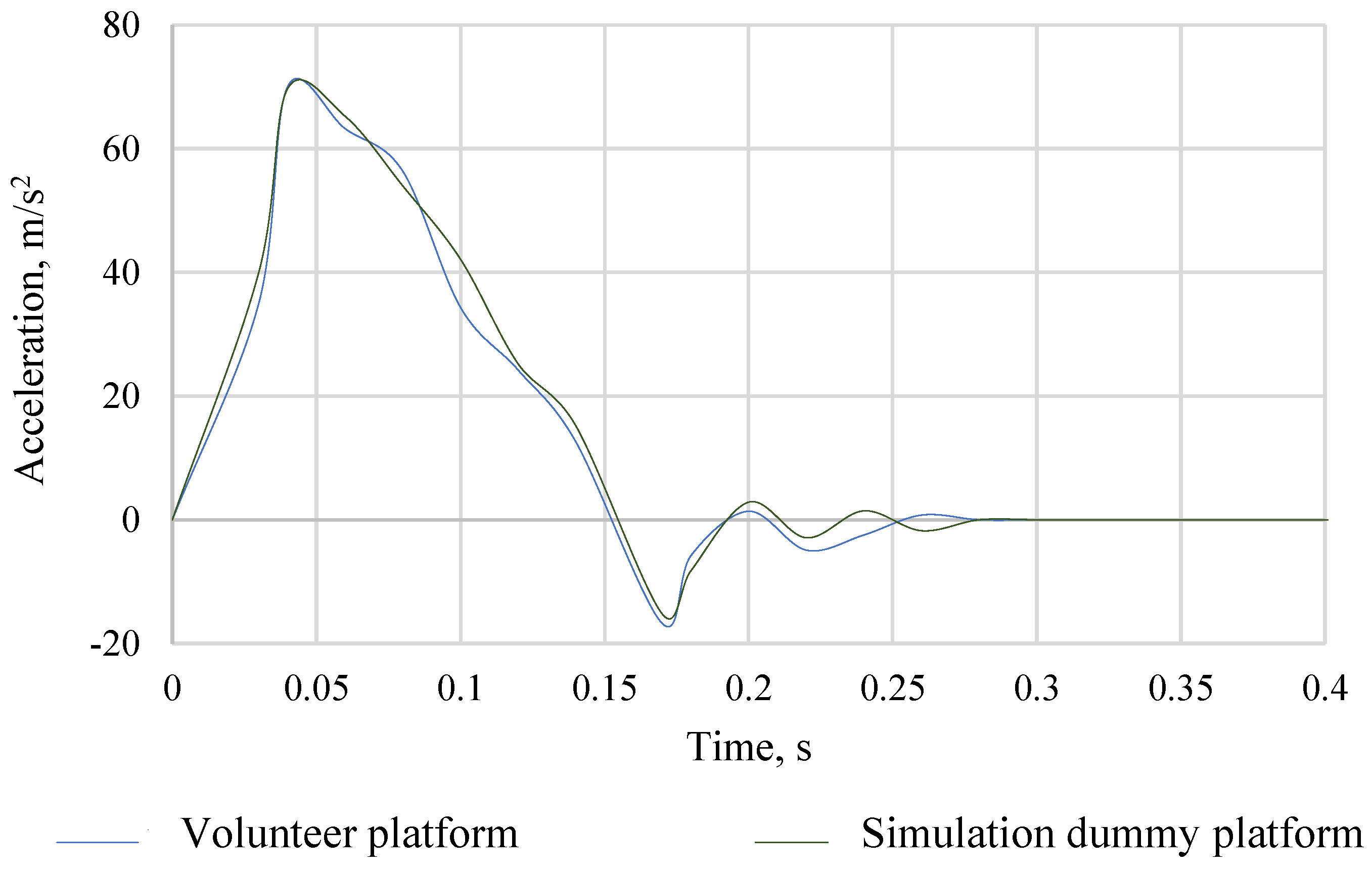
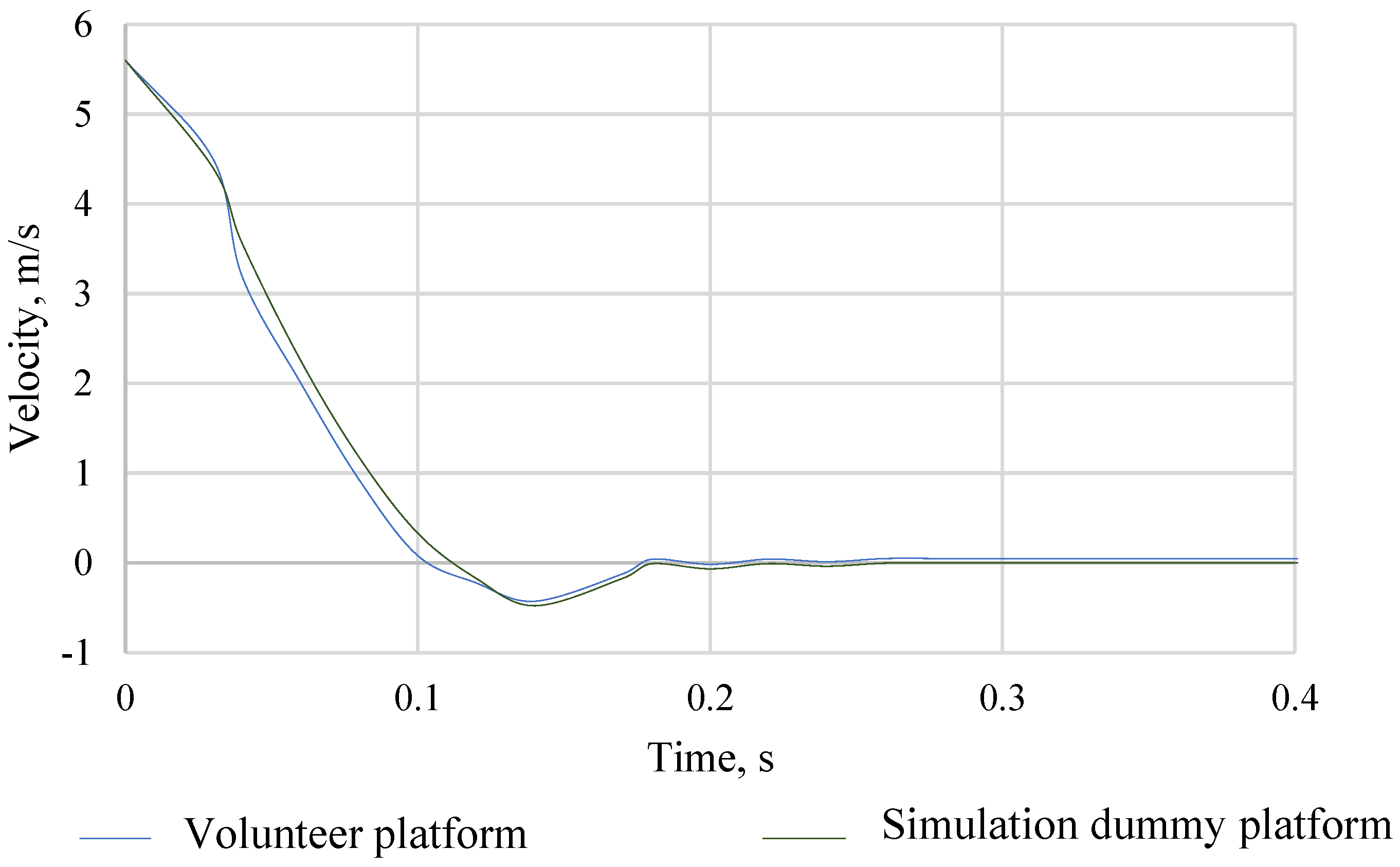
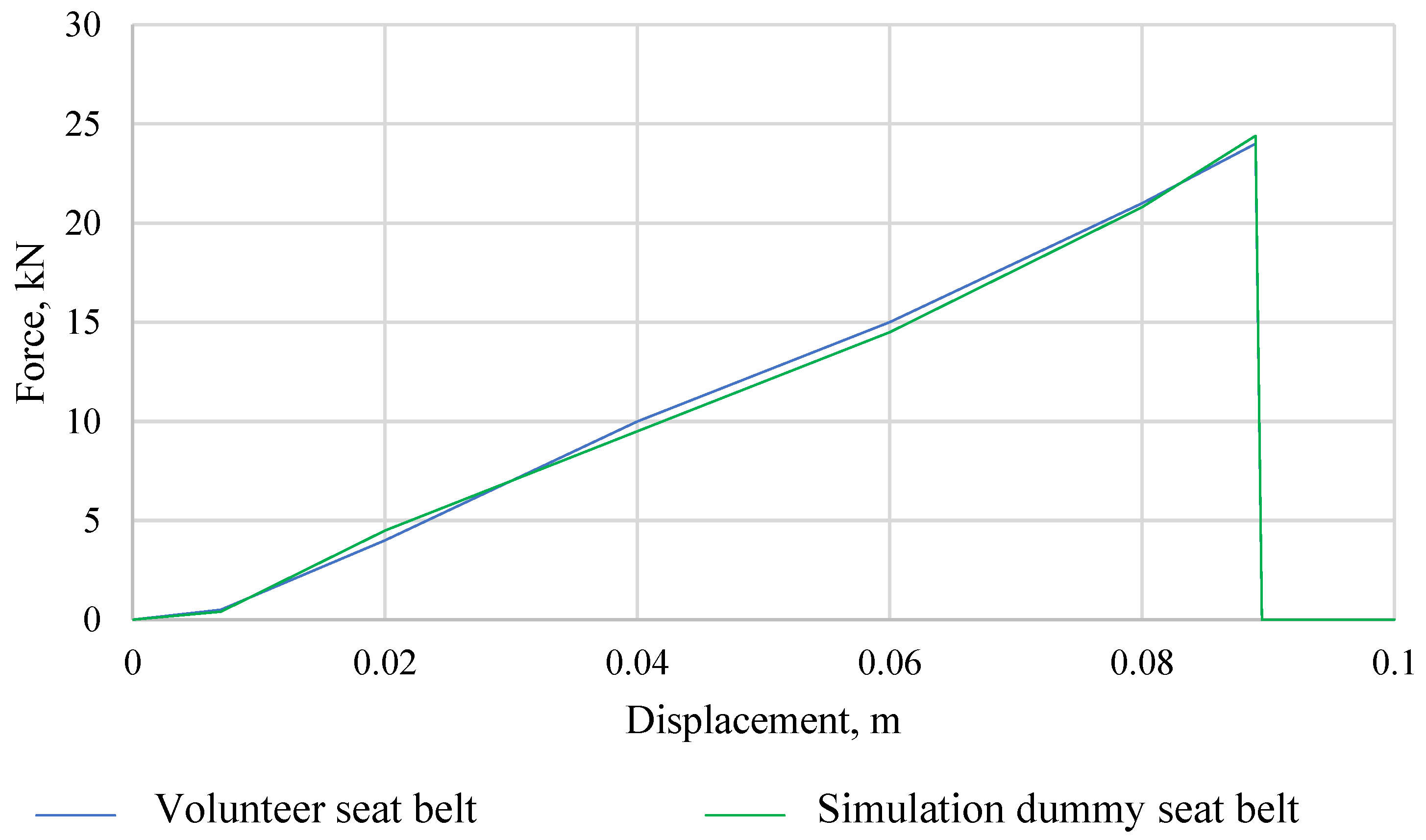


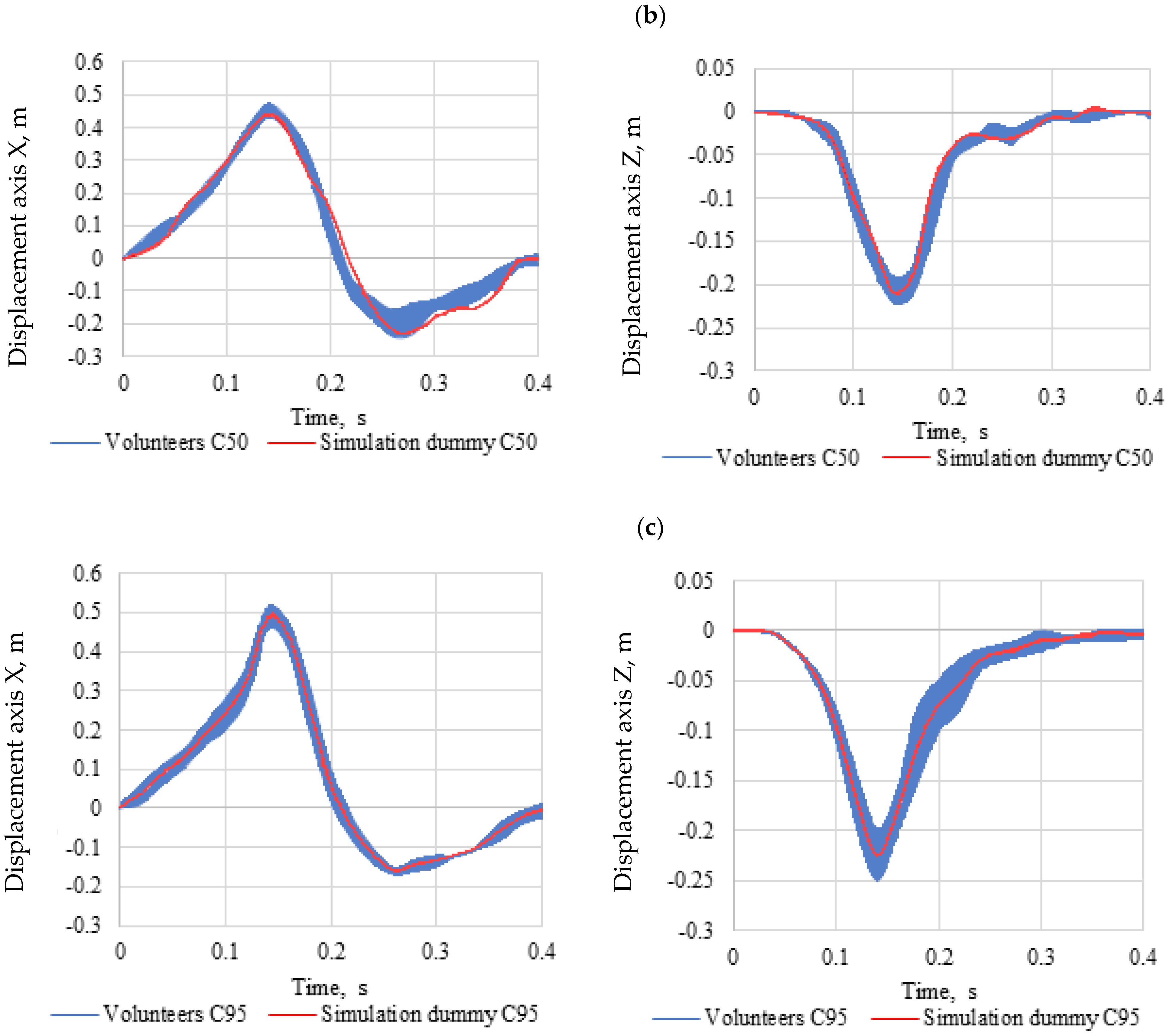

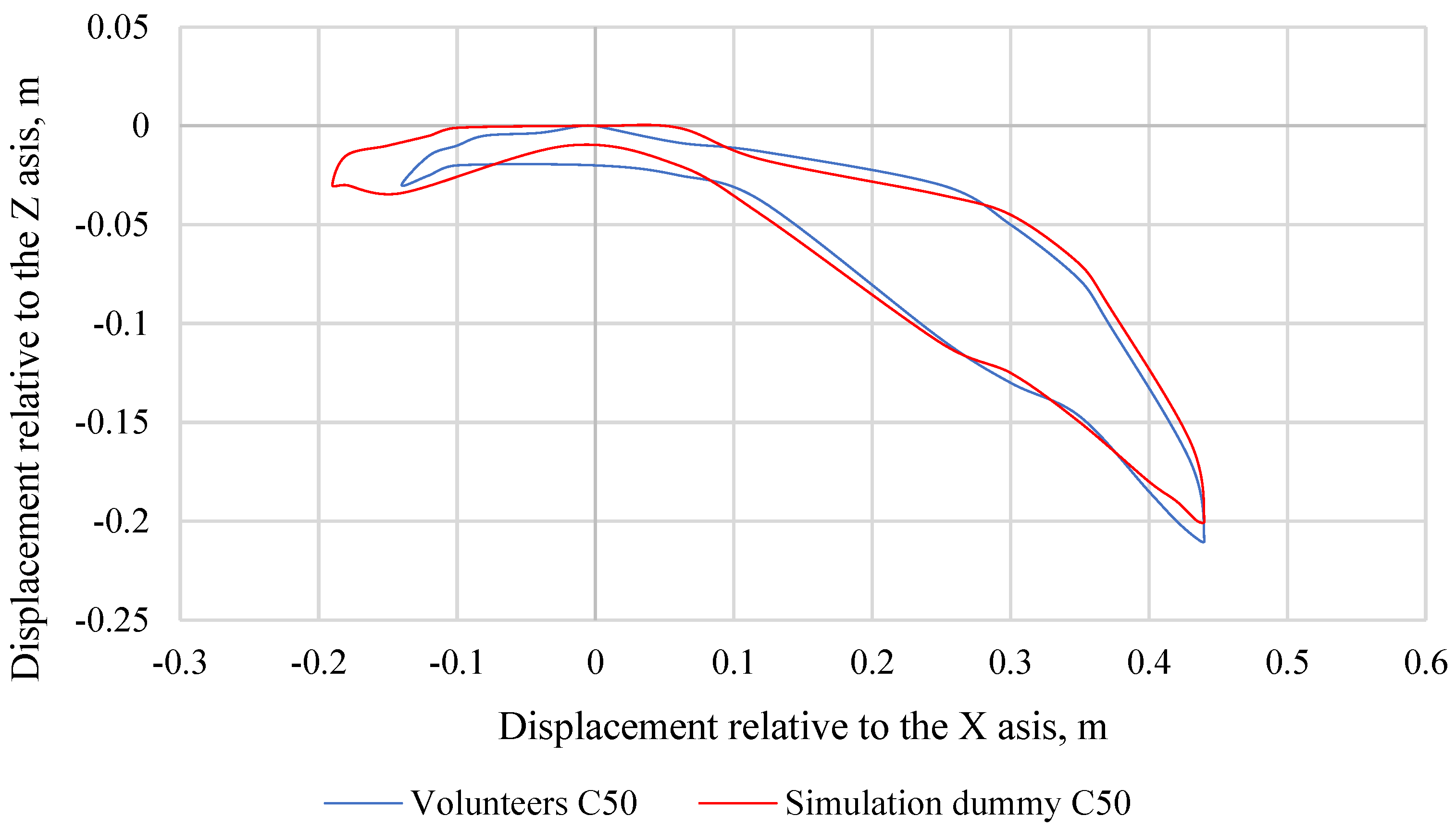

| Parameters | Values | Assignment to the Population Percentile |
|---|---|---|
| Mass [kg] | 65 | C50 |
| Height [cm] | 175 | C50 |
| Head circumference [cm] | 59 | C95 |
| Torso length [cm] | 60 | C95 |
| Chest circumference [cm] | 95 | C50 |
| Arm circumference [cm] | 37 | C50 |
| Arm length [cm] | 33 | C50 |
| Forearm circumference [cm] | 31 | C50 |
| Wrist circumference [cm] | 20 | C50 |
| Wrist width [cm] | 10 | C50 |
| Hand width [cm] | 22 | C50 |
| Thigh circumference [cm] | 57 | C50 |
| Circumference of the lower Leg [cm] | 40 | C50 |
| Ankle circumference [cm] | 26 | C50 |
| Foot length [cm] | 24 | C50 |
| Volunteer qualified for C50 population | ||
| LP | Simulation Dummy | |
|---|---|---|
| Block Name | Mass, kg | |
| 1 | forearm | 4.04 |
| 2 | arm | 4.00 |
| 3 | hand | 0.54 |
| 4 | shank | 10.08 |
| 5 | foot | 0.80 |
| 6 | thigh | 11.98 |
| 7 | neck | 1.54 |
| 8 | head | 4.54 |
| 9 | hips | 11.35 |
| 10 | chest | 17.64 |
| 11 | belly | 12.19 |
| (Σ) | 78.70 kg | |
| LP | Episode | Simulation Dummy |
|---|---|---|
| Length, mm | ||
| 1 | head (GZ) | 161 |
| 2 | neck (ZW) | 124 |
| 3 | chest + belly (WV) | 443 |
| 4 | hip (VH) | 110 |
| 5 | thigh (HK) | 310 |
| 6 | drumstick with foot (KS) | 445 |
| 7 | arm (BL) | 255 |
| 8 | forearm with hand (LN) | 243 |
| Joint | Δφ | Δφmin, Deg | Δφmax, Deg |
|---|---|---|---|
| Z | φ1 − φ2 | −10 | 55 |
| W | φ2 − φ3 | −35 | 5 |
| V | φ3 − φ4 | −85 | 30 |
| H | φ4 − φ5 | 55 | 195 |
| K | φ6 − φ5 | −130 | 0 |
| B | φ7 − φ3 | −230 | 0 |
| L | φ8 − φ7 | 0 | 150 |
| Body Parts | Unit | Simulation Dummy M50 |
|---|---|---|
| moment of inertia of the neck | kg·m2 | 0.003 |
| moment of inertia of the head | kg·m2 | 0.024 |
| moment of inertia of the upper torso | kg·m2 | 0.248 |
| moment of inertia of the middle part of the torso | kg·m2 | 0.198 |
| moment of inertia of the lower torso | kg·m2 | 0.062 |
| moment of inertia of the arm | kg·m2 | 0.023 |
| moment of inertia of the forearm | kg·m2 | 0.007 |
| moment of inertia of the hand | kg·m2 | 0.001 |
| moment of inertia of the thigh | kg·m2 | 0.183 |
| moment of inertia of the leg | kg·m2 | 0.093 |
| moment of inertia of the foot | kg·m2 | 0.004 |
Publisher’s Note: MDPI stays neutral with regard to jurisdictional claims in published maps and institutional affiliations. |
© 2022 by the authors. Licensee MDPI, Basel, Switzerland. This article is an open access article distributed under the terms and conditions of the Creative Commons Attribution (CC BY) license (https://creativecommons.org/licenses/by/4.0/).
Share and Cite
Frej, D.; Jaśkiewicz, M. Comparison of Volunteers’ Head Displacement with Computer Simulation—Crash Test with Low Speed of 20 km/h. Sensors 2022, 22, 9720. https://doi.org/10.3390/s22249720
Frej D, Jaśkiewicz M. Comparison of Volunteers’ Head Displacement with Computer Simulation—Crash Test with Low Speed of 20 km/h. Sensors. 2022; 22(24):9720. https://doi.org/10.3390/s22249720
Chicago/Turabian StyleFrej, Damian, and Marek Jaśkiewicz. 2022. "Comparison of Volunteers’ Head Displacement with Computer Simulation—Crash Test with Low Speed of 20 km/h" Sensors 22, no. 24: 9720. https://doi.org/10.3390/s22249720
APA StyleFrej, D., & Jaśkiewicz, M. (2022). Comparison of Volunteers’ Head Displacement with Computer Simulation—Crash Test with Low Speed of 20 km/h. Sensors, 22(24), 9720. https://doi.org/10.3390/s22249720






